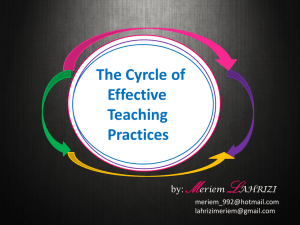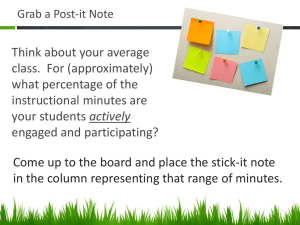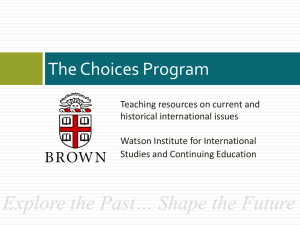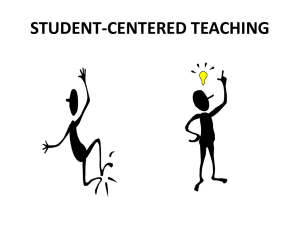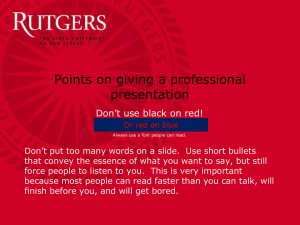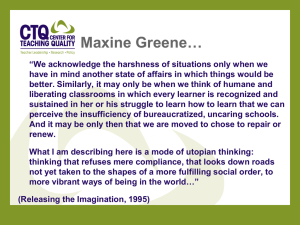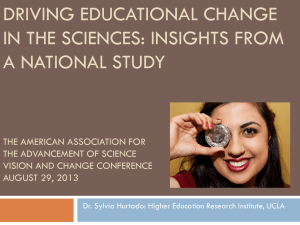Student Centered Learning Brief
advertisement
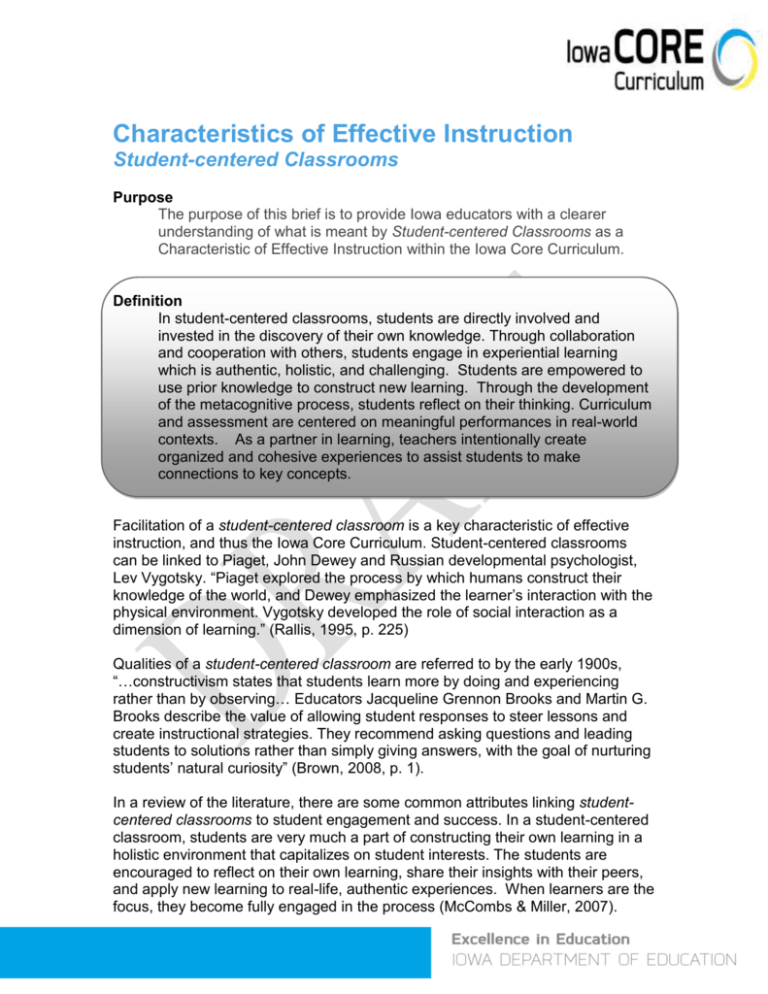
Characteristics of Effective Instruction Student-centered Classrooms Purpose The purpose of this brief is to provide Iowa educators with a clearer understanding of what is meant by Student-centered Classrooms as a Characteristic of Effective Instruction within the Iowa Core Curriculum. Definition In student-centered classrooms, students are directly involved and invested in the discovery of their own knowledge. Through collaboration and cooperation with others, students engage in experiential learning which is authentic, holistic, and challenging. Students are empowered to use prior knowledge to construct new learning. Through the development of the metacognitive process, students reflect on their thinking. Curriculum and assessment are centered on meaningful performances in real-world contexts. As a partner in learning, teachers intentionally create organized and cohesive experiences to assist students to make connections to key concepts. Facilitation of a student-centered classroom is a key characteristic of effective instruction, and thus the Iowa Core Curriculum. Student-centered classrooms can be linked to Piaget, John Dewey and Russian developmental psychologist, Lev Vygotsky. “Piaget explored the process by which humans construct their knowledge of the world, and Dewey emphasized the learner’s interaction with the physical environment. Vygotsky developed the role of social interaction as a dimension of learning.” (Rallis, 1995, p. 225) Qualities of a student-centered classroom are referred to by the early 1900s, “…constructivism states that students learn more by doing and experiencing rather than by observing… Educators Jacqueline Grennon Brooks and Martin G. Brooks describe the value of allowing student responses to steer lessons and create instructional strategies. They recommend asking questions and leading students to solutions rather than simply giving answers, with the goal of nurturing students’ natural curiosity” (Brown, 2008, p. 1). In a review of the literature, there are some common attributes linking studentcentered classrooms to student engagement and success. In a student-centered classroom, students are very much a part of constructing their own learning in a holistic environment that capitalizes on student interests. The students are encouraged to reflect on their own learning, share their insights with their peers, and apply new learning to real-life, authentic experiences. When learners are the focus, they become fully engaged in the process (McCombs & Miller, 2007). 9/17/09 SCC 2 Julie Brown describes student-centered classrooms in Student-centered Instruction: Involving Students in Their Own Education, “Put simply, studentcentered instruction is when the planning, teaching, and assessment revolve around the needs and abilities of the students” (Brown, 2008, p. 1). Attributes of a Student-centered Classroom Critical attributes of the Student-centered classroom include: Construction of learning Metacognition Teacher/student partnership in learning Collaborative learning Meaningful assessment in real-world contexts Construction of learning Armed with the knowledge of students’ previous understanding of concepts, student centered teachers create situations that allow students to make connections to new ideas. These connections can then be developed into entirely new concepts that continue to grow throughout a student’s experiences. A deep understanding occurs when new information offered through higher order thinking activities prompts the learner to rethink and reshape prior ideas. A classroom teacher must be prepared to offer a variety of learning opportunities to meet the needs of all students as each of us constructs our own meaning about issues, problems and topics. Metacognition Metacognition is thinking about your thinking. In order for students to be metacognitive they must know how and know the need to think about their thinking. In a student-centered classroom, teachers facilitate opportunities for students to be metacognitive. Teachers in learner-centered schools understand learning to be a self-regulated, ongoing process of making sense of the world through concrete experience, collaborative discourse, and reflection (Twomey Fosnot, 2005). Teachers can assist students to acquire a set of strategies, define goals, and monitor their progress (Darling –Hammond, et al., 2008). Providing opportunities for students to reflect on what and how they learn creates an environment where students take responsibility for their learning and become more of a partner with their teacher in engaging in meaningful learning experiences. Teacher/Student partnership in learning The classroom teacher must possess a deep understanding of the developmental characteristics of their students as well as how students learn to be an effective partner in the learning process. A student centered teacher will design learning experiences that explicitly link essential concepts and skills to students’ current understanding and 9/17/09 SCC 3 natural curiosity about the topic. Students are engaged in decision making in the classroom and have the opportunity to more fully explore topics. We are most effective as teachers when we help our students discover the power of their own minds to work in their own ways to achieve success. “Few students develop a sense of academic, selfefficacy by becoming mired in what they cannot do.” (Tomlinson & Jarvis, 2006, p.19). Collaborative Learning Teachers who rely exclusively on lecture are missing an important brainbased principle: people are social and the brain grows in a social environment. New meaning comes through social interaction, so the connection between students is important. Cooperative learning and collaboration should be encouraged (Jensen, 1998). The student centered teacher recognizes this principle of learning and actively infuses collaborative opportunities into each lesson. Collaboration provides students opportunities to learn from their peers and to gain skills that will be beneficial throughout their lives. Meaningful assessment in real-world context When students are engaged in activities that result in authentic and challenging applications, they are more highly motivated to learn. A combination of real-world assessment and the attributes of Assessment for Learning provide student centered classroom teachers with the challenge of moving away from paper and pencil exams. As teachers begin—and continue—to search for ways to provide meaningful assessment for their students, their instructional activities will begin to fold into and overlap with intended assessment. Students and teachers alike will begin to monitor their teaching and learning and to make necessary adjustments to their actions. A true learning culture will result. Creating a student-centered classroom is not considered an easy task. One of the most complex factors in a student-centered classroom is that of maintaining balance. Each of the five above mentioned attributes is quite an involved concept and may call for extensive learning and practice on the part of the teacher. A true student-centered classroom offers a balance of each of these attributes. A balance of these attributes will empower students to take control of their learning and create classroom teachers who are true facilitators of learning. There are myths about the concept of student-centered classrooms, too. It is important to develop an understanding of what a student-centered classroom is but also of what a student-centered classroom is not. A student-centered classroom is not a student –controlled classroom. Student-centered teachers can expect the same, if not better, classroom behavior from students who are actively engaged in their learning. The partnership between teacher and students contributes to the collaborative learning culture. A student-centered classroom does not ignore guiding standards of content or cognition. Aligning learning activities to essential concepts and skills is a key attribute of SCC. 9/17/09 SCC 4 Using student’s prior knowledge in combination with essential concepts and skills provides for instruction that is both more motivating and engaging. Student-centered classrooms are not factory-model education with one size fits all instructional approaches or passive sitting, listening, and note-taking without recursive discourse. Educators who believe in identifying what works for different students under different conditions and delivering it to them may find student-centered learning appealing. Studentcentered learning is not minimally guided and does not exclude direct instruction techniques. In fact, student-centered learning actively utilizes direct instruction on a just-in-time basis (Hmelo-Silver et al., 2007). Direct instruction and other learning techniques are utilized at the times that they work best within a studentcentered learning experience. Each student has their own wealth of background knowledge and experiences and each student has their own preferred learning style. Teachers in a student-centered classroom will create opportunities for learning that take each of those student traits into consideration. Students will be expected to learn and grow in their understandings enough to develop new understandings. Evidence Base As schools become more familiar with this characteristic of effective instruction, they will begin to realize that the benefits are many and varied. Brown states, “…(T)hrough student-centered learning, students become self-sufficient, creative thinkers and people who appreciate and value the subject being taught” (2008, p. 2). Jackson & Davis (2000) in Turning Points 2000, a revision of the 1989 Carnegie Corporation report, provided insights into curriculum, assessment, and instruction. To be authentic, “achievement must reflect: construction of knowledge, disciplined inquiry, and value beyond school” (Newmann, Marks, & Gamoran, 1995, p. 3). The Carnegie document refers to previous research by Brooks and Brooks, (1993), Bransford et al., (1999), and Zemelman, Daniels, and Hyde (1998) concluding that constructivism is one of the best practices for learning. Newmann and colleagues (1995) describe the authentic instruction that addresses the construction of knowledge and requires students to engage in higher-order thinking. The authors suggest implementation of several key ideas: connect new information to old, engage students in challenging work, offer choices, stress learning that is experiential, provide opportunities to work collaboratively, and assess understanding using authentic means and products. All are elements of a student-centered classroom. Newmann and his colleagues discussed authentic assessment tasks as part of the model to promote authentic achievement. His research generally confirms the value of authentic learning. In a study of twenty-four public schools, when teaching was consistent with standards for authentic instruction, assessment, and performance, students achieved at high levels, regardless of social background (1996). Newmann and associates believe standards must be in place for what constitutes authentic intellectual activity in order to have significant cognitive learning. These standards can be used to improve learning activities and assessment. 9/17/09 SCC 5 Another research study also indicated better performance through authentic instructional settings. Silver and Lane (1995) demonstrated that middle school students were able to outperform their peers in a demographically similar school when they participated in the QUASAR Project, a mathematics program that emphasized reasoning, problem solving, and understanding in poor and minority student populations. The QUASAR Project focused on instructional practices that offer meaningful experiences for students and assessment that assesses student performance on open-ended tasks involving mathematical problem solving, reasoning and communication. One of the main contributions of the multi-year QUASAR project is the improvement to instructional practices based on the validity of the assessment data provided to teachers and school administrators. The following section shows how Student-centered Classrooms relates to the three connecting elements of the Core Curriculum regarding Planning, Instructing and Assessment. Planning –Student-centered classrooms are a planned process. Problems can be structured around big ideas to provide a framework with which to gather information and build knowledge. Make learning high-interest and personalized…“If students are introduced to topics that interest them, they’re more likely to be motivated.” (Jones, 2007, p. 13). Realize “students and teachers are partners in a caring relationship and be willing to be co-learners and co-creators of learning experiences.” (McCombs & Miller, 2007, p. 110). SCC teachers plan with an emphasis on the knowledge of who their learners are both individually and collectively and are armed with the best available knowledge about learning and about the best teaching practice. (McCombs & Miller, 2007). Instructing—Student-centered instruction revolves around the needs and abilities of the students. A student-centered school offers each child many opportunities to learn. Teachers experiment with different approaches to learning to enable each child’s different learning style. (Brooks & Brooks, 1993). Teachers facilitate a variety of learning opportunities - experiential, holistic, authentic, and challenging in a student-centered classroom. 9/17/09 SCC 6 Constructing ideas or systems is interactive. (Zemelman, Daniels, & Hyde, 2005). “Learner-centered teachers recognize that knowledge construction is not entirely an individual process…The teachers question and probe to help children make meaning. They listen carefully, encouraging reflection and stimulating new connections and interpretations.” (Rallis, 1995, p. 226). “The teacher’s role is more that of a facilitator than instructor; the students are active participants in the learning process. The teacher helps to guide the students, manage their activities, and direct their learning. Being a teacher means helping people to learn – and, in a student-centered class, the teacher is a member of the class as a participant in the learning process.” (Jones, 2007, p. 2). Assessment—Student centered assessment is authentic. Without training, most learners cannot accurately judge what they do and don’t know. (Paschler et al. 2007). For collaborative group work to have an impact, teachers must design effective learning tasks. The tasks must have clear outcomes and be interdependent among the students. The teacher needs to carefully monitor activities and give constant feedback. (Darling-Hammond, 2005). Performance assessments are those involving students in activities, which require them to demonstrate mastery of certain performance skills or their ability to create products that meet certain standards of quality. (Stiggins, 2001). Conclusion - The primary goal of student-centered classrooms is to help students become independent. By keeping students at the center of one’s classroom, a teacher can encourage and inspire students to seek out knowledge and to strive for understanding at a deeper level. Through this process, students see a greater relevance for and a stronger connection to the subject at hand. Through student-centered instruction, our students can achieve independent minds and the capacity to make educational decisions and value judgments.… (Brown, 2008, p. 5). Facilitating the tenets of the student-centered classroom will be an essential ingredient in implementing the characteristics of effective instruction in the Iowa Core Curriculum. 9/17/09 SCC 7 Sources for Student-centered Classrooms Brooks, J. & Brooks, M. (1993). The case for constructivist classrooms. Alexandria, VA: Association for Supervision and Curriculum Development. Brown, J. (2008). Student-centered instruction: Involving students in their own education. Music Educators Journal. 94(5). Darling-Hammond, L. & Bransford, J. (Eds.) (2005). Preparing teachers for a changing world. San Francisco: Jossey-Bass. Darling-Hammond, L., Barron, B., Cervetti, G., Pearson, P. D., Schoenfeld, A. H., Stage, E. K., et al. (2008) Powerful learning: What we know about teaching for understanding. San Francisco; Jossey-Bass. Hmelo-Silver, C.E., Duncan, R.G., & Chinn, C.A. (2007). Scaffolding and achievement in problem-based and inquiry learning: A response to Kirschner, Sweller, and Clark (2006). Educational Psychologist, 42(2), 99107. Jackson, A. & Davis, G. (2000). Turning points 2000: Educating adolescents in the 21st century. New York: Teachers College Press. Jensen, E. (1998). Teaching with the brain in mind. Alexandria, VA: ASCD. Jones, L. (2007). The Student-centered classroom. University Press. New York: Cambridge McCombs, B. & Miller, L. (2007). Learner-centered classroom practices and assessments. Thousand Oaks, CA: Corwin Press. Newmann, F., Marks, H. & Gamoran, A. (1995) A guide to authentic instruction and assessment: Vision, standards, and scoring. Madison, WI: Wisconsin Center for Education Research. Newmann, F. & Associates (1996). Authentic Achievement. San Francisco, CA: Josey Bass. Paschler, H. et al. (2007). Organizing instruction and study to improve student learning. National Center for Education Research. Rallis, S. (1995). Creating learner centered schools: Dreams and practices. Theory Into Practice. 34(4), 224-229. Silver, E.A. and Lane, S. (1995). Can instructional reform in urban middle schools help students narrow the mathematics performance gap? Some evidence from the QUASAR Project. Research in Middle Level Education Quarterly, Vol. 18(2), 49-70. 9/17/09 SCC 8 Tomlinson, C. & Jarvis, J. (2006). Teaching beyond the book. Educational Leadership, ASCD Publication. 16-21. Twomey Fosnot, C. (2005). Constructivism: Theory, perspectives, and practice. (2nd ed.) New York: Teachers College Press. Zemelman, S., Daniels, H. & Hyle, A. (2005). Best practice: Today’s standards for teaching & learning in America’s schools, (3rd Ed.) Portsmouth, New Hampshire: Heinemann. 9/17/09 SCC 9 Student-centered Classrooms Example
